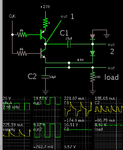mmwicant
Newbie level 5
Divide by 2, H-Bridge, step-down, switched-capacitor, charge-pump - Operation principle of is shown the attached jpg.
Suppose we look at node “bottom”.
In steady-state it toggles between voltages (Vin+ε)/2 and 0V, while Vout is at ~(Vin-ε)/2.
i.e. the bottom right transistor experiences OFF and ON states in opposite polarities !
The involved voltages are >>5V so NMOS and PMOS are asymmetrical, due to the multiple wells that enable the high VDS operation.
For example for PMOS:
VSD>0 and VSG>Vth => Isd>0 (ON state)
VSD>0 and VSG<Vth => Isd~0 (OFF state)
But when VSD<0 regardless of VSG, the diodes between Drain and Bulk will conduct.
I.e. reverse SD polarity enable current through diodes.
Should the Bottom Right switch be realized by a PMOS?
And if yes, do you agree it will run negative direction current through the its diodes?
Is it OK?
Should it work like that?
Suppose we look at node “bottom”.
In steady-state it toggles between voltages (Vin+ε)/2 and 0V, while Vout is at ~(Vin-ε)/2.
i.e. the bottom right transistor experiences OFF and ON states in opposite polarities !
The involved voltages are >>5V so NMOS and PMOS are asymmetrical, due to the multiple wells that enable the high VDS operation.
For example for PMOS:
VSD>0 and VSG>Vth => Isd>0 (ON state)
VSD>0 and VSG<Vth => Isd~0 (OFF state)
But when VSD<0 regardless of VSG, the diodes between Drain and Bulk will conduct.
I.e. reverse SD polarity enable current through diodes.
Should the Bottom Right switch be realized by a PMOS?
And if yes, do you agree it will run negative direction current through the its diodes?
Is it OK?
Should it work like that?

